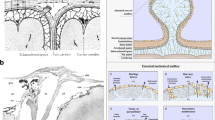Abstract
It was firmly established in the mid-twentieth century that the arachnoid villi represented an open pathway between the subarachnoid space and the dural venous sinuses. Intracellular and extracellular pathways within the villous structure provided the conduit for cerebrospinal fluid (CSF) and particulate matter. The importance of the lymphatic system was established by the demonstration of CSF tracers entering the nasal lymphatic system via the perineural subarachnoid space enveloping the olfactory nerve rootlets. It appears that because of the late development of the arachnoid villus (AV) system, the lymphatic outflow system is the more dominant one in the young animal, but in the mature animal the importance of both systems appears equal. In general, the lymphatic system in lower animals appears dominant, but in the case of primates, this may not be the case. The global outflow system has a definite opening pressure of ca. 50–70 mm of water, and the balance between production of CSF and absorption occurs at a resting pressure of ca. 115 mm water. The bicompartmental CSF outflow curves obtained from hydrocephalic patients support the presence of a dual outflow system utilized in normal CSF drainage.
Access this chapter
Tax calculation will be finalised at checkout
Purchases are for personal use only
Similar content being viewed by others
References
Boulton M, Amstrong D, Flessner M, Hay J, Szalai JP, Johnston M (1998) Raised intracranial pressure increases cerebrospinal fluid drainage through arachnoid villi and extra cranial lymphatics. Am J Physiol 275:R889–R896
Bozanovic-Sosic R, Mollanji R, Johnston M (2001) Spinal and cranial contributions to total cerebrospinal fluid transport. Am J Physiol Regul Integr Comp Physiol 281:R909–R916
Cserr HF, Harling-BergCJ KPM (1992) Drainage of brain extracellular fluid into blood and deep cervical lymphatics and its immunological significance. Brain Pathol 4:269–276
Cutler RWP, Page L, Galicih J, Watters GV (1968) Formation and absorption of cerebrospinal fluid. Brain 91:707–720
Davson H, Segal MB (1984) Physiology of the cerebrospinal fluid and blood-brain barriers, 1st edn. CRC Press, London, pp 489–523
Edsbagge M, Tissel M, Jacobsson L, Wikkelso C (2004) Spinal cerebrospinal fluid absorption in healthy individuals. Am J Physiol Regul Integr Comp Physiol 287:R1450–R1455
Eisenberg HM, Mcomb JG, Lorenzo AV (1974) Cerebrospinal fluid overproduction and hydrocephalus associated with choroid plexus papilloma. J Neurosurg 40:381–385
Eksted J (1977) Cerebrospinal fluid hydrodynamic studies in man. J Neurol Neurosurg Psychiatry 40:105–119
Grzybowski DM, Holman DW, Katz SE, Lubow M (2006) In vitro model of cerebrospinal fluid outflow through human arachnoid granulations. Invest Ophthamol Vis Sci 47:3664–3672
Lorenzo AV, Page LK, Watters GV (1970) Relationship between cerebrospinal fluid formation, absorption, and pressure in human hydrocephalus. Brain 93:679–690
MacAulay N, Zeuthen T Water transport between CNS compartments: contributions of aquaporins and cotransporters. Neuroscience.(2010 ) 168(4):941–56
Mann JD, Maffeo CJ, Rosenthal JD, Johnson RN, Butler AB, Bass NH (1976) Regulation of intracranial pressure in rat, dog and man: manometric assessment of cerebrospinal fluid dynamics using a constant flow system. Trans Am Neurol Assoc 101:182–185
Sokolowski SJ (1976) Bolus injection test for measurement of cerebrospinal fluid absorption. J Neurol Sci 28:491–504
Squier W, Lindberg E, Mack J, Darby S (2009) Demonstration of fluid channels in human dura and their relationship to age and intradural bleeding. Childs Nerv Syst 25:925–931
Tripathi BJ, Tripathi RC (1974) Vacuolar trans cellular channel as a drainage pathway for cerebrospinal fluid. J Physiol 239:195–206
Upton ML, Weller RO (1985) The morphology of cerebrospinal fluid drainage pathways in human arachnoid granulations. J Neurosurg 63:867–875
Welch K, Friedman V (1960) The cerebrospinal fluid valves. Brain 83:454–469
Welch K, Pollay M (1963) The spinal arachnoid villi of monkeys Ceropithe aethopis and Macaca irus. Anat Rec 145:43–48
Conflicts of interest statement
We declare that we have no conflict of interest.
Author information
Authors and Affiliations
Corresponding author
Editor information
Editors and Affiliations
Rights and permissions
Copyright information
© 2012 Springer-Verlag/Wien
About this paper
Cite this paper
Pollay, M. (2012). Overview of the CSF Dual Outflow System. In: Aygok, G., Rekate, H. (eds) Hydrocephalus. Acta Neurochirurgica Supplementum, vol 113. Springer, Vienna. https://doi.org/10.1007/978-3-7091-0923-6_10
Download citation
DOI: https://doi.org/10.1007/978-3-7091-0923-6_10
Published:
Publisher Name: Springer, Vienna
Print ISBN: 978-3-7091-0922-9
Online ISBN: 978-3-7091-0923-6
eBook Packages: MedicineMedicine (R0)




